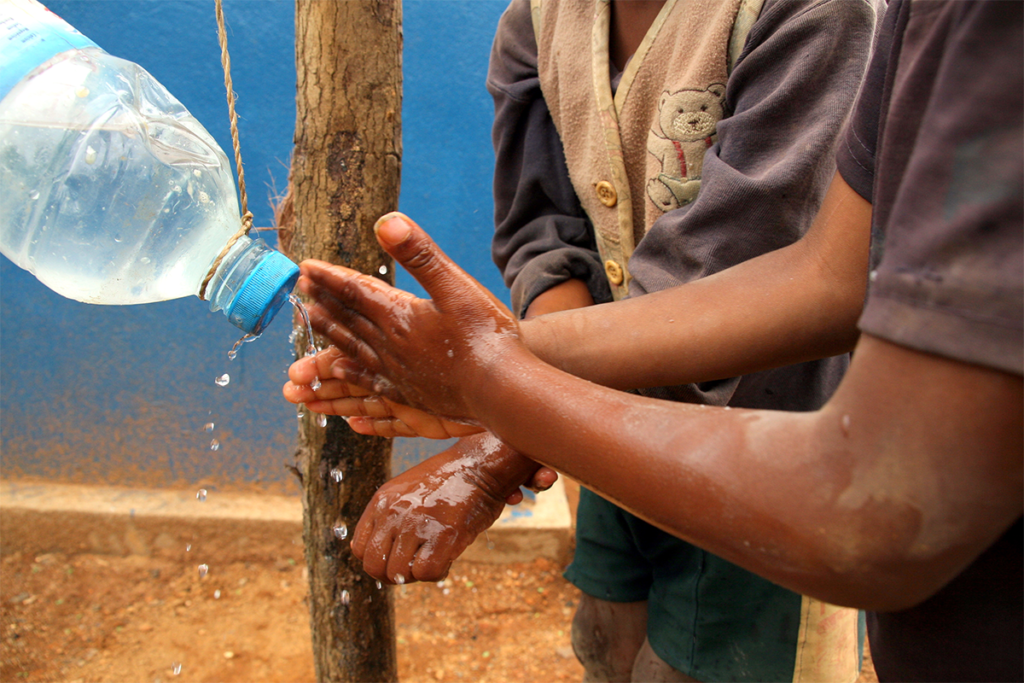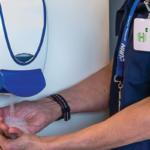Each year, USAID and the Global Handwashing Partnership compile the latest evidence around handwashing with soap to raise awareness of the persistent inequalities in handwashing access and practice. Recent research reflects the emerging interest in handwashing, both as a response to the COVID-19 pandemic and as a sustainable preventive measure once the pandemic passes. In this post, I summarize and reflect on the findings from the latest handwashing research and call for handwashing scale up beyond the current pandemic.
Access to handwashing facilities
A recent systematic review by Mbakaya, Kalembo and Zgambo (2020) aims to assess the use, benefits, adoption and effectiveness of the tippy tap, a common do-it-yourself solution. The researchers systematically searched for articles through various databases using search terms such as tippy taps, enabling technology, handwashing station and handwashing behavior. Their review includes studies using a tippy tap handwashing station regardless of the design. Findings show that the availability of tippy taps increases handwashing and use of soap at least initially. The review concludes that tippy taps can help in promoting handwashing practice in resource-constrained settings.
A recent compendium developed by the Institute of Development Studies provides further guidance and examples of accessible, low-cost handwashing facilities. The compendium provides information on key design principles and considerations, noting that the highlighted handwashing facilities are often a starting point and should be adapted based on context, user preferences and practicalities. For example, WaterAid Bangladesh highlights an easy-to-use and context-based handwashing facility as part of their response to COVID-19 in their recent report. The proposed pedal-operated handwashing station minimizes excess water and can be made more inclusive for children and people with disabilities. By using user-centered design, this innovation not only encourages people to practice frequent handwashing but limits cross-contamination among its users, an important design principle in the context of COVID-19 and other illnesses.
As the research suggests, do-it-yourself or low-cost handwashing facilities offer a simple and immediate solution. In times of crisis, these technologies allow governments to rapidly roll out handwashing stations and supplies in public settings to control the spread of disease. However, it is important to note that these facilities are a stopgap effort; that is, they do not offer a long-term solution for desirable facilities. It is critical that governments commit to prioritizing access to handwashing infrastructure and supplies through national budgets, plans and strategies.
Handwashing behavior change
A recent literature review by White et al. (2020) validates the need for multi-modal approaches to address handwashing behavior change. The review seeks to appraise the quality of evidence around handwashing determinants in domestic settings. The authors searched three databases for terms related to handwashing and behavior change determinants – assessing the quality of determinants against a pre-defined set of criteria for qualitative, quantitative and mixed-method studies. Overall, the review suggests that much of the existing research is biased toward exploring a narrow range of behavioral determinants. To successfully change handwashing behavior, the authors propose that programs evaluate a range of determinants rather than just education about disease transmission.
Another recent study by Watson et al. (2020) explored handwashing determinants in humanitarian settings. In an internally displaced persons camp in Northern Iraq, the researchers conducted a series of friendship-paired interviews with children from ages 7-12 years, exploring motivational drivers of children’s behavior. Children, caregivers and hygiene promoters all perceive the determinants of child handwashing to be associated with environmental factors pertaining to location and quality of handwashing materials and facilities, a familial role, and level of exposure to handwashing promotion. Children also attribute their handwashing to social norms and motivation from play and nurture. The findings suggest that soap and water alone is not sufficient to encourage children to practice handwashing with soap in a humanitarian context, corroborating White et al.’s findings that suggest a range of determinants must be evaluated to change handwashing behavior.
Findings from both studies suggest that equal consideration should be given to the quality and location of handwashing materials as well as other determinants, such as social norms, which can be leveraged to promote and enhance handwashing. Interventions that address these key determinants are likely to be most effective when used in conjunction. These findings are especially critical as implementers look toward handwashing programming beyond COVID-19.
Scaling up handwashing
Note: The Global Handwashing Partnership is a public-private partnership working to advance handwashing with soap. The Partnership leads global advocacy and knowledge management activities, including Global Handwashing Day every October 15. To learn more about the partnership, visit www.globalhandwashing.org
Photo caption: A tippy tap outside of new WASH-friendly latrines built by villagers in Madagascar
Photo credit: Shahbaz Fawbush, MD/FHI 360



